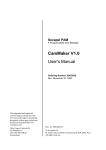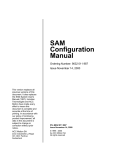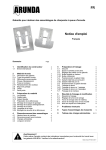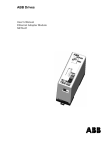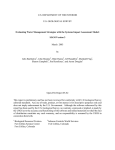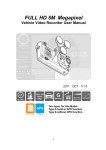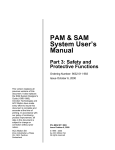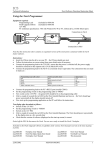Download PAM System V2.6 Release Notes
Transcript
Socapel PAM A Programmable Axes Manager PAM System V2.6 Release Notes Ordering Number: 006.8030 Rev. 4 June 1996 This upgraded and improved version replaces all the previous. We reserve the right to amend this document without prior notice and decline all responsibilities for eventual errors. Atlas Copco Controls SA En Montillier 4 CH-1303 PENTHAZ Switzerland Doc. No. 006.8030/CJO June 1996 by Atlas Copco Controls SA (previously SOCAPEL SA). All rights reserved. Table of Contents PAM System V2.6 --- Release Notes TABLE OF CONTENTS 1 INTRODUCTION ------------------------------------------------------------------------------------------1—1 1.1 System 2.6 Software Installation --------------------------------------------------------------------------- 1—1 2 CHANGES FROM PREVIOUS VERSION ---------------------------------------------------------2—1 2.1 PAMTools------------------------------------------------------------------------------------------------------- 2—1 2.2 PAM Compiler------------------------------------------------------------------------------------------------- 2—2 2.3 PAM Firmware ------------------------------------------------------------------------------------------------ 2—4 2.4 CamMaker------------------------------------------------------------------------------------------------------ 2—4 2.5 PAMCAM2 ----------------------------------------------------------------------------------------------------- 2—4 Doc. No. 006.8030 Rev. 04 June 1996 Page I Introduction PAM System V2.6 --- Release Notes 1 INTRODUCTION This manual provides information on the use of specific features and improvements introduced in PAM SYSTEM 2.6 software. PAM SYSTEM 2.6 software includes PAMTools, the Win95 based successor to PAMDEBUG, the PAM Compiler and CAMMaker. All PAM SYSTEM 2.6 programs may be run under Windows 3.X or Win95. This manual is a complement to the PAM Reference Manual 006.8007.B and the PAM User's Manual 006.8017.A. All information contained in this document will be integrated into the next revisions of the PAM Reference and User's Manuals. 1.1 SYSTEM 2.6 SOFTWARE INSTALLATION WINDOWS 3.X 1. Insert disk marked "Disk 1/6" into the floppy disk drive. 2. In the Program Manager, select RUN from the FILE menu. 3. Type <DRIVE_NAME>:SETUP.EXE, where <drive_name> is the name of the floppy disk drive. 4. Click on OK. 5. Follow the on-screen installation instructions. A "Socapel Tools" group is created. The PAMTools and CamMaker programs are placed in it. 6. To start any of these programs, double-click on its icon. WINDOWS95 1. Insert disk marked "Disk 1/6" into the floppy disk drive. 2. Select RUN from the START menu. 3. Type <DRIVE_NAME>:SETUP.EXE, where <drive_name> is the name of the floppy disk drive. 4. Click on OK. 5. Follow the on-screen installation instructions. A "Socapel tools" group is created in the START MENU PROGRAMS. The PAMTools and CamMaker programs are placed in it. 6. To start any of these programs, click on its icon. i The PAM compiler is placed in the same directory (Socatool) as the Windows programs Doc. No. 006.8030 Rev. 04 June 1996 Page 1—1 Changes from Previous Version PAM System V2.6 --- Release Notes 2 CHANGES FROM PREVIOUS VERSION This chapter describes the differences in the operation and use of SYSTEM 2.6 component programs compared to Version 2.5. 2.1 PAMTOOLS PAMTools is a general name applied to PAM system software, but PAMTools is also the name of a specific program (based on the old PAMDEBUG program) for communicating with PAM. The PAMTools program offers all the advantage of the Windows environment (Toolbar, etc...) in addition to the following new user-friendly functions: SCANNING/MODIFYING OBJECTS It is now possible to scan and modify objects using their names instead of ID codes. While the PAM is running, choose SCAN or SEND/MODIFY in OBJECTS menu or click on, respectively or in the toolbar. In the dialogue box, type the name of the object or select it from the list of available objects using the browser. Dualport variables can now also scanned/modified just like any other variables. SCANNING NAMELESS EQUATIONS Some equation objects do not have names, for example in the following statement: ... CONDITION ... I1 * I2 ; the expression " I1 * I2 " is a nameless equation. Nameless equations can now be scanned using symbols like: BEQ_<file>_<ext>_L<line>_C<column> For example, the symbol " BEQ_divzer_AGL_L109_C16 " represents the equation located in file DIVZER.AGL at line 109 and column 16. SEQUENCE SNAPSHOOT Starting with this version, sequences snapshots can be taken. Snapshots contain information about sequences states, waiting causes and starting causes. To take a snapshot, choose "Sequence Snapshot" in "Objects" menu while the PAM is running, or click on in the toolbar. Snapshot information can then be saved and edited in a .PSS (PAM Sequence Snapshot) file. APPLICATION HANDLING Information on the application actually running in PAM as well as application saved in PAM is accessible. Doc. No. 006.8030 Rev. 04 June 1996 Page 2—1 Changes from Previous Version PAM System V2.6 --- Release Notes TIME AND DATE ADJUSTMENT Choose SET DATE TIME in the DEVICE menu to synchronize PAM internal time with the PC time. PAM STATES PAM’s current operating state (see Figure 11) is displayed in the bottom status bar. RESET BUSY RUN RESET RUNNING BOOT_REQUEST Fatal Error Power Up BOOTING BOOT_REQUEST FATAL ERROR Figure 1 PAM Operating States Diagram To set BOOT_REQUEST: Choose START... in the DEVICE menu and then select BOOT_REQUEST in the dialogue box or click on in the toolbar. To set RUN: Choose RUN... in the DEVICE menu or click on in the toolbar. To set RESET: Choose START... in the DEVICE menu and then select RESET in the dialogue box. 2.2 PAM COMPILER COMPILATION Starting with this version, PAM applications can be compiled in a DOS box when running Windows 3.x or Windows95 using the following procedure. 1. Edit the application. Page: 2—2 Doc. No. 006.8030 Rev. 04 June 1996 Changes from Previous Version PAM System V2.6 --- Release Notes 2. Save the application as a pure ASCII file with the extension AGL . 3. Open a DOS box. 4. Move to the application's AGL directory. 5. Compile the application by typing PAMCOMP <APPLICATION>[.agl] If the compilation is successful, three files are generated in the AGL directory: • • • <application>.PAI, the application to be downloaded to the PAM. <application>.SYD, application symbols information. <application>.PSI, application objects information. APPLICATION SIZE Compressed application size is now checked at compilation, which allows larger applications. Previously, the compression factor was defined as 2, now factors up to 3 are allowed. HEXADECIMAL NUMBERS Syntax for hexadecimal numbers is now C-like: Old : #4F2 New: 0x4F2 BITWISE OPERATORS Three bitwise operators have been added: | : OR. & : AND. ~ : NOT. Examples: MyVar <- 0x23FC | 237 ; MyVar <- 0x3456 & 0x0040 ; MyVar <- ~456 ; COMPILATION PROBLEM Some executables have same name in DOS version (\PAM\BIN\...) and in Windows version (\SOCATOOL\...), you must not have both paths in the PATH command of your autoexec.bat file . PREPROCESSOR PROBLEM You must not put comments on a #define line: Wrong: #define PI 3.14 // This comment causes problems Right: // A comment #define PI Doc. No. 006.8030 Rev. 04 June 1996 3.14 Page 2—3 Changes from Previous Version PAM System V2.6 --- Release Notes 2.3 PAM FIRMWARE The following problems have been solved • • 2.4 Ready condition after an axis STOP command didn't appear in some rare cases. In some cases, if an EXCEPTION occurred during an ENCODER inquire, this ENCODER was then unable to be accessed. CAMMAKER CamMaker has not been modified. Refer to the CamMaker User's Manual (p/n 006.8028) for more information. 2.5 PAMCAM2 PAMCAM2 is an additional software which converts cams designed for PAM V2.0...V2.3 to PAM V2.6 format without any improvement (keeps the PAM V2.0..V2.3 parabolic interpolation). It is available on a separate disk and runs only on Windows 95. Page: 2—4 Doc. No. 006.8030 Rev. 04 June 1996







